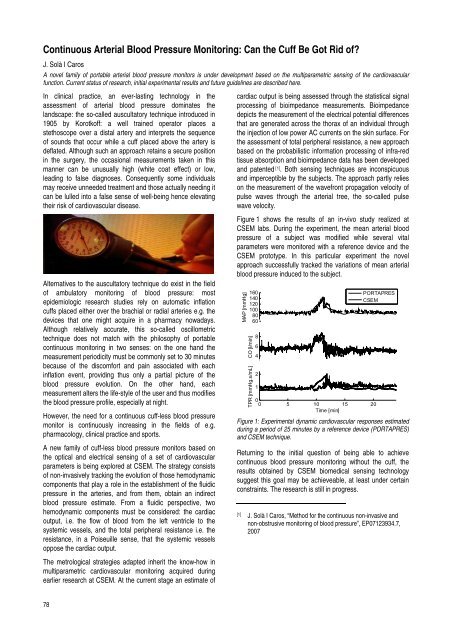research activities in 2007 - CSEM
research activities in 2007 - CSEM
research activities in 2007 - CSEM
You also want an ePaper? Increase the reach of your titles
YUMPU automatically turns print PDFs into web optimized ePapers that Google loves.
Cont<strong>in</strong>uous Arterial Blood Pressure Monitor<strong>in</strong>g: Can the Cuff Be Got Rid of?<br />
J. Solà I Caros<br />
A novel family of portable arterial blood pressure monitors is under development based on the multiparametric sens<strong>in</strong>g of the cardiovascular<br />
function. Current status of <strong>research</strong>, <strong>in</strong>itial experimental results and future guidel<strong>in</strong>es are described here.<br />
In cl<strong>in</strong>ical practice, an ever-last<strong>in</strong>g technology <strong>in</strong> the<br />
assessment of arterial blood pressure dom<strong>in</strong>ates the<br />
landscape: the so-called auscultatory technique <strong>in</strong>troduced <strong>in</strong><br />
1905 by Korotkoff: a well tra<strong>in</strong>ed operator places a<br />
stethoscope over a distal artery and <strong>in</strong>terprets the sequence<br />
of sounds that occur while a cuff placed above the artery is<br />
deflated. Although such an approach reta<strong>in</strong>s a secure position<br />
<strong>in</strong> the surgery, the occasional measurements taken <strong>in</strong> this<br />
manner can be unusually high (white coat effect) or low,<br />
lead<strong>in</strong>g to false diagnoses. Consequently some <strong>in</strong>dividuals<br />
may receive unneeded treatment and those actually need<strong>in</strong>g it<br />
can be lulled <strong>in</strong>to a false sense of well-be<strong>in</strong>g hence elevat<strong>in</strong>g<br />
their risk of cardiovascular disease.<br />
Alternatives to the auscultatory technique do exist <strong>in</strong> the field<br />
of ambulatory monitor<strong>in</strong>g of blood pressure: most<br />
epidemiologic <strong>research</strong> studies rely on automatic <strong>in</strong>flation<br />
cuffs placed either over the brachial or radial arteries e.g. the<br />
devices that one might acquire <strong>in</strong> a pharmacy nowadays.<br />
Although relatively accurate, this so-called oscillometric<br />
technique does not match with the philosophy of portable<br />
cont<strong>in</strong>uous monitor<strong>in</strong>g <strong>in</strong> two senses: on the one hand the<br />
measurement periodicity must be commonly set to 30 m<strong>in</strong>utes<br />
because of the discomfort and pa<strong>in</strong> associated with each<br />
<strong>in</strong>flation event, provid<strong>in</strong>g thus only a partial picture of the<br />
blood pressure evolution. On the other hand, each<br />
measurement alters the life-style of the user and thus modifies<br />
the blood pressure profile, especially at night.<br />
However, the need for a cont<strong>in</strong>uous cuff-less blood pressure<br />
monitor is cont<strong>in</strong>uously <strong>in</strong>creas<strong>in</strong>g <strong>in</strong> the fields of e.g.<br />
pharmacology, cl<strong>in</strong>ical practice and sports.<br />
A new family of cuff-less blood pressure monitors based on<br />
the optical and electrical sens<strong>in</strong>g of a set of cardiovascular<br />
parameters is be<strong>in</strong>g explored at <strong>CSEM</strong>. The strategy consists<br />
of non-<strong>in</strong>vasively track<strong>in</strong>g the evolution of those hemodynamic<br />
components that play a role <strong>in</strong> the establishment of the fluidic<br />
pressure <strong>in</strong> the arteries, and from them, obta<strong>in</strong> an <strong>in</strong>direct<br />
blood pressure estimate. From a fluidic perspective, two<br />
hemodynamic components must be considered: the cardiac<br />
output, i.e. the flow of blood from the left ventricle to the<br />
systemic vessels, and the total peripheral resistance i.e. the<br />
resistance, <strong>in</strong> a Poiseuille sense, that the systemic vessels<br />
oppose the cardiac output.<br />
The metrological strategies adapted <strong>in</strong>herit the know-how <strong>in</strong><br />
multiparametric cardiovascular monitor<strong>in</strong>g acquired dur<strong>in</strong>g<br />
earlier <strong>research</strong> at <strong>CSEM</strong>. At the current stage an estimate of<br />
78<br />
cardiac output is be<strong>in</strong>g assessed through the statistical signal<br />
process<strong>in</strong>g of bioimpedance measurements. Bioimpedance<br />
depicts the measurement of the electrical potential differences<br />
that are generated across the thorax of an <strong>in</strong>dividual through<br />
the <strong>in</strong>jection of low power AC currents on the sk<strong>in</strong> surface. For<br />
the assessment of total peripheral resistance, a new approach<br />
based on the probabilistic <strong>in</strong>formation process<strong>in</strong>g of <strong>in</strong>fra-red<br />
tissue absorption and bioimpedance data has been developed<br />
and patented [1] . Both sens<strong>in</strong>g techniques are <strong>in</strong>conspicuous<br />
and imperceptible by the subjects. The approach partly relies<br />
on the measurement of the wavefront propagation velocity of<br />
pulse waves through the arterial tree, the so-called pulse<br />
wave velocity.<br />
Figure 1 shows the results of an <strong>in</strong>-vivo study realized at<br />
<strong>CSEM</strong> labs. Dur<strong>in</strong>g the experiment, the mean arterial blood<br />
pressure of a subject was modified while several vital<br />
parameters were monitored with a reference device and the<br />
<strong>CSEM</strong> prototype. In this particular experiment the novel<br />
approach successfully tracked the variations of mean arterial<br />
blood pressure <strong>in</strong>duced to the subject.<br />
MAP [mmHg]<br />
160<br />
140<br />
120<br />
100<br />
80<br />
60<br />
CO [l/m<strong>in</strong>]<br />
TPR [mmHg.s/mL]<br />
8<br />
6<br />
4<br />
2<br />
1<br />
0<br />
0 5 10<br />
Time [m<strong>in</strong>]<br />
15 20<br />
PORTAPRES<br />
<strong>CSEM</strong><br />
Figure 1: Experimental dynamic cardiovascular responses estimated<br />
dur<strong>in</strong>g a period of 25 m<strong>in</strong>utes by a reference device (PORTAPRES)<br />
and <strong>CSEM</strong> technique.<br />
Return<strong>in</strong>g to the <strong>in</strong>itial question of be<strong>in</strong>g able to achieve<br />
cont<strong>in</strong>uous blood pressure monitor<strong>in</strong>g without the cuff, the<br />
results obta<strong>in</strong>ed by <strong>CSEM</strong> biomedical sens<strong>in</strong>g technology<br />
suggest this goal may be achieveable, at least under certa<strong>in</strong><br />
constra<strong>in</strong>ts. The <strong>research</strong> is still <strong>in</strong> progress.<br />
[1] J. Solà I Caros, “Method for the cont<strong>in</strong>uous non-<strong>in</strong>vasive and<br />
non-obstrusive monitor<strong>in</strong>g of blood pressure”, EP07123934.7,<br />
<strong>2007</strong>








